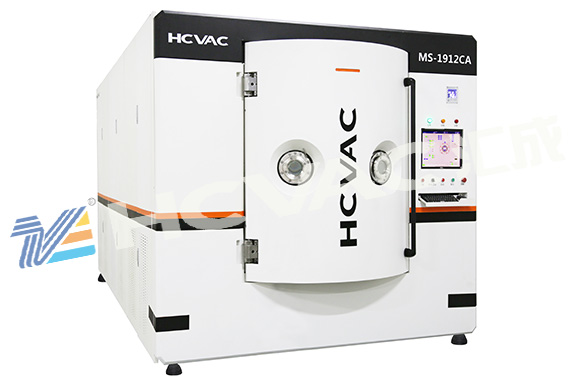Modern
pvd coating machines are mainly composed of vacuum chamber, vacuum acquisition part, vacuum measurement part, power supply part, process gas input system, mechanical transmission part, heating and temperature measurement parts, ion evaporation or sputtering source, system system and other parts.
pvd coating machines mainly come in two forms: continuous coating production lines and single-chamber coating machines. Since mold coating has high requirements on heating and mechanical transmission parts, and mold shapes and sizes vary widely, continuous coating production lines are usually difficult to meet the requirements. A single-chamber coating machine must be used.

In vacuum technology, the vacuum acquisition part is an important component. Due to the high adhesion requirements of the mold coating, the background vacuum degree before the start of the coating process is preferably higher than 6mPa, and the vacuum degree after the coating process can even reach more than 0.06mPa, so it is suitable
Reasonable selection of vacuum acquisition equipment to achieve high vacuum degree is crucial. At present, there is no pump that can operate from atmospheric pressure to close to ultra-high vacuum. Therefore, the acquisition of vacuum cannot be achieved by one vacuum equipment and method. Several pumps must be used in combination, such as mechanical pumps, molecular pump systems, etc.
The vacuum measurement part of the vacuum system is to measure the pressure in the vacuum chamber. Like a vacuum pump, no vacuum gauge can measure the entire vacuum range, so people have made many types of vacuum gauges based on different principles and requirements.
The target power supply mainly includes DC power supply (such as MDX) and intermediate frequency power supply (such as PE, PEII, and PINACAL produced by the American AE Company); the workpiece itself usually requires a DC power supply (such as MDX) and pulse power supply (such as the PINACAL+ produced by the American AE Company). , or radio frequency power (RF).
Process gases, such as argon (Ar), krypton (Kr), nitrogen (N2), acetylene (C2H2), methane (CH4), hydrogen (H2), oxygen (O2), etc., are generally supplied by gas cylinders. Gas pressure reducing valve, gas stop valve, pipeline, gas flow meter, solenoid valve, piezoelectric valve, and then lead to the vacuum chamber. The advantage of this gas input system is that the pipeline is simple and clear, and it is easy to repair or replace the gas cylinder. Each coating machine does not affect each other. There are also cases where multiple coating machines share a set of gas bottles. This situation is not applicable in some regulations.
Coating shops with larger molds may have the opportunity to see it. Its advantage is that it reduces the occupancy of gas cylinders and provides unified planning and layout. The disadvantage is that due to the increase in joints, the chance of air leakage increases. Moreover, each coating machine will interfere with each other. Air leakage in the pipeline of one coating machine may affect the product quality of other coating machines. In addition, when replacing gas bottles, it must be ensured that all hosts are in a non-gas state.
Tool coating requires that the thickness must be uniform around the perimeter. Therefore, there must be three rotation amounts during the coating process to meet the requirements. That is, when the large workpiece table is required to rotate (I), the small workpiece supporting table also rotates (II), and the workpiece itself can also rotate at the same time (III).
In terms of mechanical design, there is usually a large driving gear in the center of the bottom of the large workpiece turntable, surrounded by some small planetary wheels that mesh with it, and then a shift fork is used to rotate the workpiece. Of course, when doing mold coating, two rotation amounts are generally enough, but the gear load capacity must be greatly enhanced.
The evaporation source of multi-arc plating in
pvd coating machines is generally round cake-shaped, commonly known as round cake targets. In recent years, rectangular multi-arc targets have also appeared, but no obvious effect has been seen. The round cake target is installed on the copper target base (cathode base), and the two are connected by ribs. The target base is equipped with a magnet. By moving the magnet back and forth to change the magnetic field intensity, the arc spot moving speed and trajectory can be adjusted. In order to reduce the temperature of the target and the target base, cooling water must be continuously supplied to the target base. In order to ensure high electrical and thermal conductivity between the target and the target base, a tin (Sn) gasket can also be added between the target and the target base. Magnetron sputtering coating generally uses rectangular or cylindrical targets.



